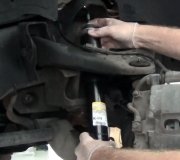No, no, no, no, no. Well, maybe, maybe, maybe, maybe, maybe. Okay, yes, yes, yes, yes, yes, sometimes. It depends on the style of wheel bearing, and I'm sure there will be some exceptions, but here's what I've found in general in the past. Changing lanes when you hear the noise is plenty of turning to make a noisy bearing get real quiet or noisy if it is a pressed-in bearing. Those were used on all Chrysler products up through 1986 and some models through 1990. Ford and Honda used them too. When you turned a little to the left, more vehicle weight went onto the right side. If that's when the noise got louder, the right bearing was the cause. Those were easy to diagnose.
Your vehicle uses a more expensive bolt-on assembly. The advantage is no special tools are needed to replace it, it's much faster to replace them, and if you replace the wrong one, you can reinstall the old one on the other side. The disadvantage is the cost. The pressed-in bearings are destroyed by removing them, but there's never a need to remove them except to replace them.
I've been fooled by the bolt-on style one too many times. That's why I use the stethoscope. My first experience with them was on an Intrepid. The noise sounded to everyone like it was coming from the right side, and it did get louder when turning left. The symptoms were exactly the same after replacing the right bearing. It turned out to be the left one was noisy. I just scratched out "right" on my repair order diagnosis and wrote in "left", then put the old bearing on the left side and the noise was gone.
Since then I've noticed that these bolt-on bearings usually do not get quiet when you turn one way. I've never had the chance to try the holding-the-spring trick but my thought is if you could feel the roughness that way, you should also be able to hear it with your ear next to the spinning wheel. I can't hear anything that way, but every time I used the stethoscope, the first bearing was questionable, then the second one was obviously much louder.
I should also mention that regardless which type of bearing is used, they are held together by the cv joint, and the tightness of that axle nut is critical. Some vehicles call for up to 240 foot pounds so you'll want to invest in a click-type torque wrench. If you put any weight at all on those bearings before that nut is tight, it will instantly make the new bearing noisy.
I had a GM front-wheel-drive car to align after our body shop rebuilt it after a crash. They had the engine and transmission out so there wasn't much weight left, then they found out it was going to take a week to get some parts so they pushed it outside without the half shafts installed. That car was so light three people could lift the front end off the ground but that was enough to damage both bearings and make them noisy.
As for finding the Chassis Ear on Amazon, thank you, saturntech9. I never thought to look there. They list the wired version for 70 bucks. I just might order one for myself. The tool truck guys sell them for $199.99. The wireless version is lots cheaper too. I could never justify spending that much to find a noise on my own vehicles. It would get used so seldom so instead, I just wait for a noise to stop, then check to see what part fell off!
Thursday, May 3rd, 2012 AT 10:14 PM


